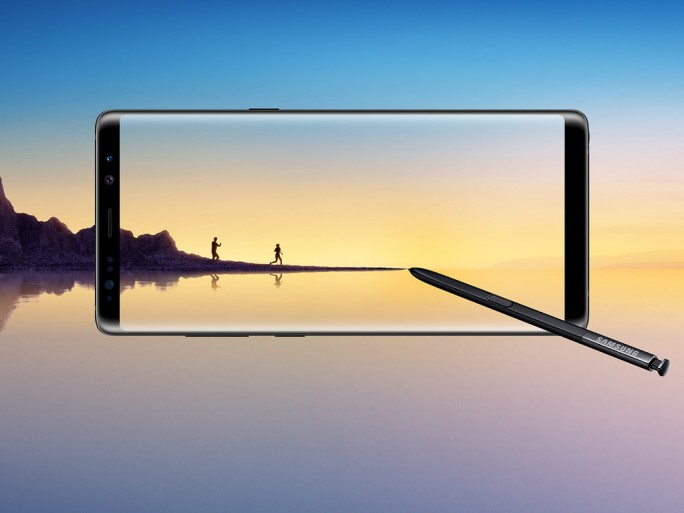Samsung Galaxy Note 8 Arrives With Infinity Display, Dual Camera & Updated S Pen

Samsung Galaxy Note 8: Samsung focuses on the Note range’s strength to finally draw a line under the Note 7 catastrophe
Samsung hopes the arrival of the Samsung Galaxy Note 8, complete with a larger screen, advanced camera and updated S Pen, will finally put an end to the debacle of its predecessor.
The new device focuses firmly on what has given the first phablet range a legion of loyal fans. The Note 8 adopts the Samsung Galaxy S8’s infinity display to allow for more screen space that can be used to create documents and images and to multitask.
The Note 8’s 6.3-inch AMOLED display is the largest ever included in a Note device.
“After years of development we can create the largest smartphone screen that can fit in our hand,” declared DJ Koh, Samsung’s mobile head, told the Samsung Unpacked launch event in New York.
Samsung Galaxy Note S8
Mulitasking is enhanced with a new App Pair feature which lets users set custom shortcuts that launch two different apps simultaneously. For example, perhaps you would pair outlook with Skype for video calls, or a music app with maps for a road trip.
The S Pen now has a finer tip, improved pressure sensitivity and GIF support. But business travellers will be pleased to learn that whole sentences can be translated from 71 languages, while units and foreign currencies can also be converted automatically.
The other key addition is the dual camera, which pairs two 12 megapixel rear lenses. One is a wide lens, while the other is a telephoto lens with 2x optical zoom. Users can save both photos and the smartphone is the first ever to have two rear cameras both equipped with optical image stabilisation (OIS).
Naturally, there is support for Samsung’s Bixby voice-activated assistant, which is now available in the UK, and DeX, which turns the device into a computer with monitor, keyboard and mouse support.
Indeed, Samsung is working with the most popular entertainment and productivity app developers to enhance functionality for DeX, which was first introduced with the Samsung Galaxy S8 earlier this year.
The smartphone is powered by a 10nm octa-core processor, 6GB of RAM and comes with up to 256GB internal storage which can then be supplemented by the same amount via a MicroSD card slot. Security is enhanced via biometric iris and fingerprint scanners, as well as the Samsung Knox platform.
Throughout the launch, Samsung was keen to promote the “cult” of the Galaxy Note, pointing out that it created the phablet category back in 2011, and continually thanking its loyal fans. But the spectre of the Note 7 was at least acknowledged.
Drawing a line under history
The Samsung Galaxy Note 7 was an unprecedented catastrophe for the company after it emerged that the batteries included in the device were prone to explosions. A partial recall led to a worldwide withdrawal that harmed the Samsung’s finances and its reputation.
It also faced criticism from environmental campaigners who were concerned about the electronic waste that might be caused. Samsung eventually said it planned to recover 157 tonnes of rare metals, including gold and silver, as well as components such as the OLED screen and cameras from the devices.
The launch of the flagship Samsung Galaxy S8 was pushed back to accommodate testing and a market campaign that aimed to ease any concerns that consumers or businesses might have about the firm’s devices. The strategy appeared to work as the Samsung Galaxy S8 has been a critical and commercial success.
Samsung says the Galaxy Note S8 has undergone an eight-point battery safety check, which it claims is the industry’s most rigorous such check.
“No one will ever forget what happened last year but I will never forget how many millions of loyalists stayed with us,” added Koh.
Critical reception
The Note 8 had been well received by industry experts who have suggested Samsung has its confidence back, buoyed by the success of the Galaxy S8, and that it has cemented its position as the leading Android manufacturer. One analyst said it might even attract a few iPhone die-hards.
“The fact Samsung was prepared to continue using the Note brand shows its belief that there is significant pent up demand for another top-of-the-line flagship device alongside the rest of its smartphone portfolio,” said Ben Wood from CCS insight.
“By maintaining the Note brand, Samsung is sticking with a tried and tested formula despite the challenges it faced with the Note 7. In so doing, Samsung is using product and marketing strength to relegate the Note 7 issue to a footnote. Had Samsung simply retired the Note brand, it would arguably have had a greater and far more negative legacy. “
The device is available from 15 September in four colours – black, grey, gold and blue.
What do you know about mobiles past and present? Try our quiz and find out!